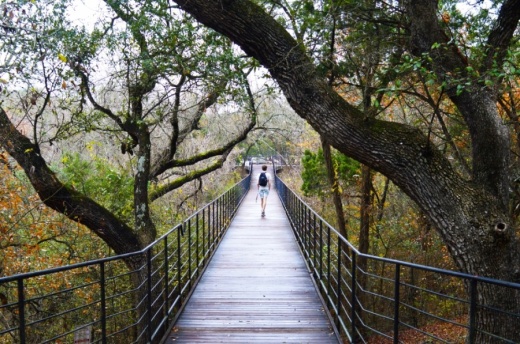By the late afternoon, however, Utzinger said his brief panic had subsided.
“From that first week I’ve been trying to think of when we go back to normal, if that happens, how can we pull forward some of these unbelievable pedagogical and technological approaches we’ve used?” he said.
Most aspects of the college experience changed in the fall because of pandemic precautions, university officials told Community Impact Newspaper. Classrooms, locker rooms and dorms were all modified to keep students healthy—and campus open—throughout the fall semester.
Currently, school officials said, it looks like most of the precautions taken by the university community will need to stay in place.
“Our game plan for next spring is very similar to our game plan for this for this fall,” said Daniel Gregory, vice president of administration at Concordia. “We just don’t have enough indicators to tell us that deviating from that plan is a good idea just yet.”
Opening campus
In order to open for its faculty and 2,500 students to begin classes in late August, Gregory said the university first needed to heavily invest in technology and safety infrastructure.
Concordia—a four-year private college off RM 620 in Northwest Austin—partnered with Austin Regional Clinic to help with testing capabilities when needed and built a “robust” contact tracing system, Gregory said, that helped quickly identify and isolate coronavirus cases on campus.
“We’ve been able to attribute ... all but one case from somewhere off campus,” Gregory said.
Following the spring 2020 semester—during which the school pivoted to virtual learning in late March—Concordia officials decided that learning would be conducted in a hybrid-flex model in the fall. This model allows for students to learn either in the classroom—with capacity limits—or completely online, with all teaching conducted simultaneously.
Concordia invested nearly $400,000 in audio and video equipment installations in every classroom as well as equipment and supplies for COVID-19 safety measures, Gregory said.
The hybrid-flex model has come with unpredicted benefits, Utzinger said. Typically, attendance dwindles in the week following Thanksgiving, according to the dean, as students are sluggish returning from campus. In his first class following the break this year, the English professor said he had a 100% attendance rate. Returned midterm reports also point to sustained academic success.
“We have not seen a drop-off [in grade point average] that I would have predicted,” Utzinger said.
However, students and faculty who spoke to Community Impact Newspaper both said one notable element of the “small school” experience was missing this fall—personal interactions between faculty and students.
President of the Student Government Board Shawn Matthijetz said that before the pandemic, he would go so far as to stop Concordia President Donald Christian in the hallway for half-hour long conversations.
“Concordia prides itself on discussion-based conversation in class, and I think that’s a huge part of the college experience, especially at a small institution where your class sizes are smaller,” Matthijetz said. “But being online obviously somewhat negates that.”
Community interaction
As person-to-person cohorts have faded out of campus life in the fall semester, so, too, have some university efforts to get its students out into the community.
Concordia annually hosts a day of service in which its incoming freshmen go into the community and perform volunteer work. This fall, incoming freshman stayed on campus to make quilts and care packages for seniors living in assisted care facilities.
“Community involvement suffered tremendously in the age of COVID,” Utzinger said.
Some students did make it out into the community, however. Concordia’s senior nursing students returned to their clinical rounds beginning on day one of the fall semester. More than 400 nursing students participated in clinicals in the fall semester, according to Jason Shuffitt, dean of the College of Health Sciences.
Because of their interaction with patients in clinical environments, Concordia isolated its nursing students from the rest of the student body, Shuffitt said.
“I did not feel comfortable with our nursing students being on campus at all, due to the fact that they are in clinic and have high risk of exposure,” Shuffitt said. “Students were not allowed and still are not allowed to take care of COVID-positive patients. That is not to say that we’ve not had students who had scares for exposure because you never know who has it.”
As part of a community clinical, Shuffitt said some of the school’s nursing students worked with agencies that serve individuals experiencing homelessness in Austin.
In the spring, Concordia nursing students will help with contact tracing efforts, and Shuffitt added it is possible some students will help to administer the COVID-19 vaccine.
Scholastic hurdles
Enrollment in colleges is down statewide, according to an Oct. 21 preliminary report from the Texas Higher Education Coordinating Board.
In the Central Texas region, enrollment is down 1.3% across the board, according to the report. Independent colleges and universities, such as Concordia, have experienced a collective half-percentage decline in enrollment in fall 2020 compared to fall 2019.
Utzinger said Concordia’s fall 2020 enrollment fell approximately 8% short of the school’s goal. Even still, the dean said that exceeded some of the best-case scenario numbers.
Looking at data for Free Application for Federal Student Aid, universities across the state may expect to see smaller incoming freshmen classes in fall 2021.
In the city of Austin, 14.9% fewer high school students as of Nov. 20 have submitted FAFSA documents—now a mandatory part of the college application process in Texas—for the 2021-22 academic school year when compared to the year prior. Similar declines are observed in Austin’s suburbs, including Cedar Park and Round Rock.
During a Dec. 1 news conference, THECB Commissioner Harrison Keller said FAFSA applications—which are “good indicators” of enrollment numbers next fall—are down approximately 4% statewide.
“The COVID-19 pandemic has been the biggest disruption for higher education since the end of the second World War,” Keller said. Spring forward
After having all in-person sports seasons canceled throughout the fall, Concordia’s 15 programs will return to competitive play in the spring.
For Concordia’s athletics department, traveling and coordinating for 300 student athletes presents a significant logistical hurdle, Director of Athletics Ronda Seagraves said.
After a fall semester in which teams practiced in small pods and entirely closed off locker rooms, Seagraves said the school will now have to coordinate buses, lodging and the possibility of hosting fans at games.
“For our outdoor venues, I think we’re going to be OK. They’re pretty big. And obviously, being outdoors is a little different than being inside. It’s going to be quite an interesting semester,” Seagraves said.
Past the spring semester, Utzinger said Concordia will likely carry forward some operational changes as the pandemic has forced administration to reconsider how higher education can be delivered to its student body.
“The past six months were incredibly stressful, and I wish we had not had to go through it at all on any level. And some of the unintended consequences, I think, will make us a better university in the future,” he said.





